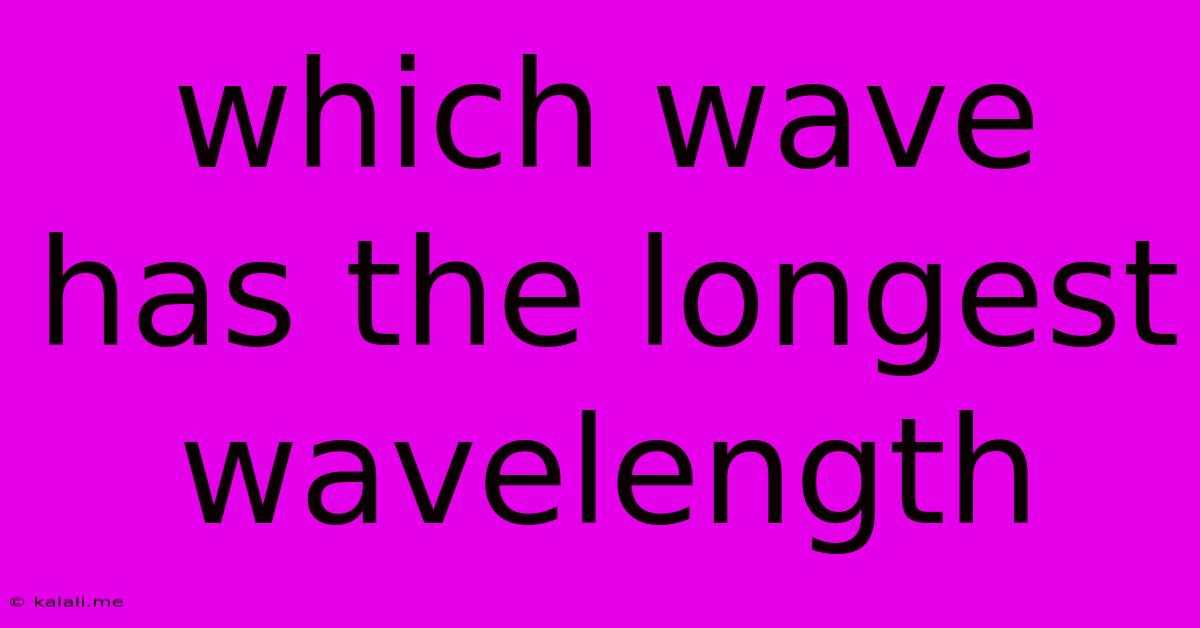Which Wave Has The Longest Wavelength
Kalali
Jun 12, 2025 · 3 min read

Table of Contents
Which Wave Has the Longest Wavelength? Exploring the Electromagnetic Spectrum
The question of which wave has the longest wavelength is best answered by exploring the electromagnetic spectrum. This spectrum encompasses all types of electromagnetic radiation, arranged according to their wavelengths and frequencies. Understanding this spectrum is key to understanding the answer. This article will delve into the different types of waves and pinpoint the one with the longest wavelength.
Understanding Wavelength and Frequency
Before diving into specific types of waves, let's clarify the relationship between wavelength and frequency. Wavelength refers to the distance between two consecutive crests (or troughs) of a wave. Frequency, on the other hand, describes the number of wave cycles that pass a given point per second, measured in Hertz (Hz). These two are inversely proportional: longer wavelengths correspond to lower frequencies, and shorter wavelengths correspond to higher frequencies.
The Electromagnetic Spectrum: A Journey Through Waves
The electromagnetic spectrum is vast, ranging from waves with extremely short wavelengths to those with incredibly long wavelengths. Let's examine some key regions:
-
Gamma Rays: These are the highest-energy, shortest-wavelength waves on the spectrum. They have wavelengths shorter than 10 picometers (pm).
-
X-rays: Shorter wavelengths than ultraviolet radiation, X-rays are used in medical imaging and various industrial applications. Their wavelengths range from 0.01 to 10 nanometers (nm).
-
Ultraviolet (UV) Radiation: UV radiation is responsible for sunburns and has shorter wavelengths than visible light. Its wavelength range is approximately 10 nm to 400 nm.
-
Visible Light: This is the portion of the spectrum we can see, encompassing the colors of the rainbow, from violet (shortest wavelength) to red (longest wavelength within visible light). Wavelengths range from approximately 400 nm to 700 nm.
-
Infrared (IR) Radiation: We experience infrared radiation as heat. It has longer wavelengths than visible light, ranging from approximately 700 nm to 1 millimeter (mm).
-
Microwaves: Used in cooking and communication technologies, microwaves have wavelengths ranging from about 1 mm to 1 meter (m).
-
Radio Waves: These waves have the longest wavelengths on the electromagnetic spectrum, ranging from 1 meter to thousands of kilometers. They are used extensively in broadcasting, communication, and various scientific applications. Within radio waves, we find different sub-bands like AM radio, FM radio, and TV broadcasts, each with its own wavelength range.
The Winner: Radio Waves
Therefore, the wave with the longest wavelength is the radio wave. The vastness of its wavelength range, extending to thousands of kilometers, surpasses all other electromagnetic waves. The specific wavelength of a particular radio wave depends on its frequency and application, but even the shortest radio waves are considerably longer than the longest microwaves or infrared radiation.
Conclusion:
Understanding the electromagnetic spectrum reveals a diverse range of waves with varying wavelengths and frequencies. While each type of wave plays a unique role, the undisputed champion in terms of longest wavelength is the radio wave. Its long reach makes it crucial for various communication technologies and scientific endeavors.
Latest Posts
Latest Posts
-
Client Server Versus Peer To Peer
Jun 13, 2025
-
Does Hand Sanitizer Kill Pinworm Eggs
Jun 13, 2025
-
Molten Rock Below The Earths Surface
Jun 13, 2025
-
A Group Of Cells With Similar Structure And Function
Jun 13, 2025
-
American University Of Sharjah Acceptance Rate
Jun 13, 2025
Related Post
Thank you for visiting our website which covers about Which Wave Has The Longest Wavelength . We hope the information provided has been useful to you. Feel free to contact us if you have any questions or need further assistance. See you next time and don't miss to bookmark.